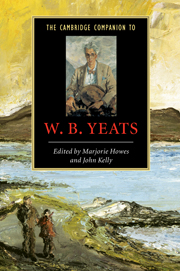Book contents
- Frontmatter
- 1 Introduction
- 2 Yeats and Romanticism
- 3 Yeats, Victorianism, and the 1890s
- 4 Yeats and Modernism
- 5 The later poetry
- 6 Yeats and the drama
- 7 Yeats and criticism
- 8 Yeats, folklore, and Irish legend
- 9 Yeats and the occult
- 10 Yeats and gender
- 11 Yeats and politics
- 12 Yeats and the postcolonial
- Bibliography
- Index
2 - Yeats and Romanticism
Published online by Cambridge University Press: 28 January 2007
- Frontmatter
- 1 Introduction
- 2 Yeats and Romanticism
- 3 Yeats, Victorianism, and the 1890s
- 4 Yeats and Modernism
- 5 The later poetry
- 6 Yeats and the drama
- 7 Yeats and criticism
- 8 Yeats, folklore, and Irish legend
- 9 Yeats and the occult
- 10 Yeats and gender
- 11 Yeats and politics
- 12 Yeats and the postcolonial
- Bibliography
- Index
Summary
W. B. Yeats summoned the term “romantic” in his poetry for two of his most famous proclamations. Both were characteristically memorial, one invoking his political mentor John O'Leary against the background of the Dublin strike and lockout of 1913, and the other honoring his literary patron and collaborator Lady Gregory shortly after her estate at Coole Park had been sold to the government in 1927. The first came in the refrain of the poem that we now know as “September 1913”: “Romantic Ireland's dead and gone, / It's with O'Leary in the grave” (VP 289).
The second inaugurated the last stanza of “Coole Park and Ballylee, 1931”:
We were the last romantics – chose for theme
Traditional sanctity and loveliness;
Whatever’s written in what poets name
The book of the people; whatever most can bless
The mind of man or elevate a rhyme.
VP 491-2The question arises, what do these two uses of the term – one political and one literary – have to do with each other? A lifelong if sometimes ambivalent Romantic, Yeats saw literature and politics as intertwined, even when he opposed the reduction of literature to mere opinion.
- Type
- Chapter
- Information
- The Cambridge Companion to W. B. Yeats , pp. 19 - 35Publisher: Cambridge University PressPrint publication year: 2006



